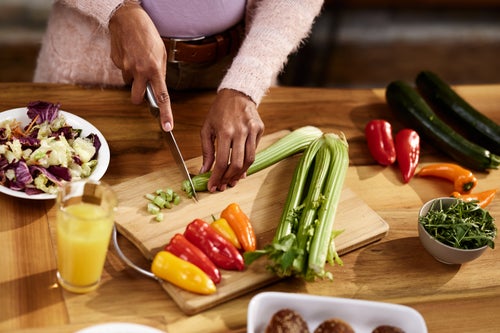

A wooden chopping board should be one of the easiest kitchen items to clean. Just pop it in the sink, wash it off with some washing-up liquid and you should be good to go, right? Apparently not.
Wooden boards are actually quite hard to sanitise effectively and if you aren’t cleaning it right it can lead to potential bacteria growth. Plastic boards, on the other hand, are quite easy to clean and maintain.
Though wooden boards are safe when cleaned properly, opting for plastic boards for meat is often a much safer bet to significantly minimise the risk of bacteria growth.
“A proper selection of chopping boards is essential for maintaining food safety and preventing cross-contamination. Wooden and plastic boards offer different advantages and both can be effective, but care must be taken to ensure food safety,” Stevie Cheape, Head Chef at Campbells Prime Meat says.
If you don’t want to swap your wooden board out for a plastic one just yet, the team at Campbell’s shares five ways you can sanitise your wooden chopping board.
Clean thoroughly after each use
The first thing you should do when cleaning a wooden chopping board is remove any food debris with a scraper or spatula.
Then, wash the board with hot, soapy water, using a brush or sponge to scrub all the surfaces, including the sides. Make sure to reach into any crevices or grooves. Rinse the board thoroughly with hot water to remove all the soap residue.
Disinfect with a natural solution
If you want to find an effective way of killing bacteria and sanitising your wooden chopping board, you should use a natural disinfectant.
One effective solution is a mixture of equal parts water and white vinegar.
Fill a spray bottle with the solution and spray it all over the board. Let it sit for a few minutes to allow the vinegar’s acidic properties to kill any bacteria. Then, rinse the board with hot water to remove the vinegar smell.
Salt to remove stains and odours
To remove stains and odours from your wooden chopping board, sprinkle a good amount of coarse salt (such as kosher salt) across the surface.
Use a lemon or half a cut of lemon to scrub the salt into the wood. The acidic properties of the lemon juice mixed with the abrasive salt help break down stains and eliminate odours.
Let the salt and lemon mixture sit on the board for twenty minutes, then wipe away the residue with a damp cloth or sponge. Rinse the board with hot water and pat it dry. Do this once every month or two.
Lightly sand for smoothing
Every few months or so you should sand your wooden chopping board to smoothen the surface and remove any knife marks.
Use fine-grit sandpaper and gently sand the board in the direction of the grain. Sanding helps remove rough areas, stubborn stains, and any buildup on the surface. After sanding, wipe away any sawdust with a clean cloth or rinse the board with water and let it dry.
Treat with oil
You should also be oiling your board every few months or whenever you salt or sand your wooden board.
Wood is porous, and regular oiling helps maintain its condition and prevents the growth of bacteria.
Apply food-grade mineral oil or a specialised cutting board oil to the wooden chopping board once a month or as needed. Spread a thin layer of oil all over the board, including the sides, and let it penetrate the wood for several hours or overnight. Wipe off any excess oil with a clean cloth before using the board again.